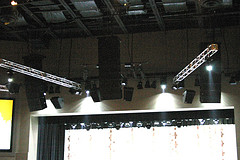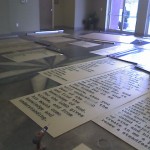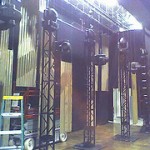
Line Array Games
I had an interesting Tuesday last week with a rare day spent down at Buckhead. In keeping with my system optimization kick, I had been wanting to get a bit of experience working with line arrays so Dustin, Buckhead’s Audio Director, let me come down to see what I could do with North Point’s new tuning rig.
I spent the morning setting up measurement mics and getting a handle on how everything was interacting. Line arrays are very interesting to me. I’m going to way oversimplify it, but the basic premise is the vertical array of speakers act as one speaker. The physics of the whole thing are pretty cool and something I’m still getting a handle on. The key to the way line arrays work is all based on spacing between speaker elements. If you can get the spacing between speakers(measured from the center of the “cone”) to 1/4 or less of the wavelength of the highest frequency the speaker will deliver, the multiple speakers will act as one speaker at that frequency. Wavelength = c/f where “c” is the speed of sound and “f” is the frequency. If the speed of sound is ~1130 feet/second, you can see that you need some pretty small distances to get line arrays to work with high frequencies–less than 5mm for 16 kHz. Loudspeaker manufacturers have come up with some innovative designs to get around this such as V-Doscs way of “slicing” up the output of their horns into small “speakers”.
Now this is all fine and dandy in a theoretical world, but there are still challenges with line arrays in the real world. One of these challenges is that the boxes in an array typically get splayed vertically for audience coverage as the boxes tend to be very directional in the vertical plane. Of course every time you splay the boxes farther apart you are lengthening the spacing between speaker elements. So the further you splay them, the less coherency between speaker elements. And as your spacing increases you don’t just lose coherency, you also actually create destructive interference through your coverage area. And keep in mind this isn’t just for your high frequencies. Most boxes are typically three way boxes so you’re extending the distance for ALL elements between boxes (high frequency driver, mid frequency driver, low-mid driver(s), etc.). As a result, line arrays seem to work best when you can do a long array and are trying to cover a large area in the vertical plane(think arena and stadium seating).
Since you have uneven spectral coverage front to back, the system optimization solution is to take multiple measurements throughout the coverage area and to average adjustments between them. This is where our new tuning rig is great because I opted to use EASERA SysTune as my software platform. SysTune lets you average multiple mics in real-time so instead of capturing and comparing several separate measurements before making an adjustment, I can view an average of the mics in real-time while I make adjustments. SysTune also lets you quickly select your different mics to view the individual traces. This worked great when I was done working with the average to see what was happening in different parts of the room; sometimes what happens in the average can be too much for an area of the room, and you just need to back off a bit on what you’re doing. It’s all a series of compromises.
This was my first time optimizing line arrays, and I was happy enough with the results I got in the room considering I only had a couple hours to work on it before 7|22 came in. I actually ended up mixing 7|22 that night, and I was a little bummed that the mix wasn’t quite translating outside the room. I am discovering I have a tendency to take too much of the low/low-mid stuff out of the system so it gets left on the individual channels which muddies up translation. If I had another twenty minutes, this could probably be fixed pretty easily by adjusting the array compensation in the Meyer Galileo’s being used for system processing. It just stinks because the last worship set of the night was really cool in the room, and I wished my copy had come out a little better.
There was a lot more to the whole 7|22 mixing experience that I’ll save for another post.


 Previous Post
Previous Post Next Post
Next Post


